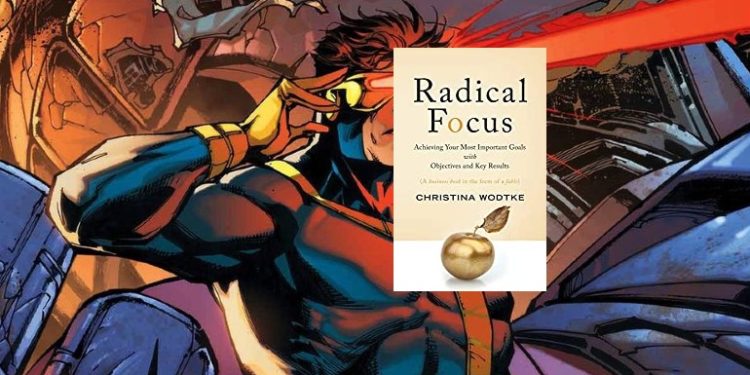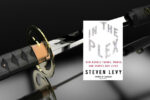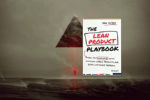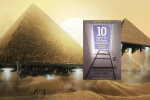An OKR Fable

OKRs blend visionary objectives with measurable outcomes. The OKR framework can inspire teams and bring focus to an entire company.
Radical Focus: Achieving Your Most Important Goals with Objectives and Key Results by Christina Wodtke
Radical Focus is about a management method called Objectives and Key Results (OKRs). The OKR method has its roots in HP’s Management by Objectives (MBO) which seeks to achieve alignment through a cascading set of objectives through the enterprise. Andy Grove, CEO of Intel, created the OKR method by decreasing the objective timeline (from annual to quarterly) and increasing the collaborative nature of the activity. OKRs were brought from Intel to Google by John Doerr where the method gained popularity within the high tech and startup communities. Doerr says the benefits of OKRs are: 1) focus; 2) alignment (from transparency); 3) commitment; 4) trackability; 5) building a risk-taking culture (from stretch goals). The recent interest in OKRs is related to their transparency, simplicity and team orientation. Environments which embrace Agile principles find an affinity with OKRs due to the way the methodology sets success criteria, emphasizes learning, and allows teams to establish solutions.
Objectives are stretch goals which are reachable, but not comfortable, in a 90 day period. Objectives are phrased as qualitative outcomes. Key Results are measurable progress towards an Objective.
OKRs are the centerpiece of a conversation between leaders and teams and within teams. Managers and their teams negotiate OKRs at the beginning of a quarter and have weekly check ins to review progress and confidence levels.
OKRs have achieved a lot of notoriety and, like methods such as Agile, everyone practices them slightly differently and claims to have the correct, nuanced, approach.
The first part of Radical Focus is a story about a startup which sells tea. The story follows the two founders, Hanna and Jack, as they start using OKRs after meeting with their largest investor. The story is well written and, although it features a conveniently happy ending with the founders reaping the benefits of OKRs, it’s not contrived. The story begins with the struggling founders meeting with their top advisor and board member who recommends OKRs. The scenarios and characters are realistic and familiar.
Hanna, the CEO, is sales and business focused while Jack, her co-founder, is passionate about design. Hanna is objective and results-oriented while Jack is altruistic and purpose-driven. They hire a CTO and deal with a variety of team problems along the way. Throughout the story, the company is struggling to find the right customers and identify its market position. When they discuss their challenges with their angel investor, Jim, he introduces them to OKRs.
Hanna is a metric-oriented CEO who balances her relationship with a technical and idealistic co-founder who doesn’t always engage with business basics. Much of the story features their back-and-forth conversations on which direction to take next in a stressful time for their fledgling company. In the background of the main narrative, the employees are taking sides with respect to the strategic choices and their own perspective on the company mission.
The focus facilitated by OKRs helps the two founders challenge each other with respect to company activities and make decisions on what type of work to engage in. In the story, OKRs also enable team members to have conversations about choices based on the reference point of OKRs.
Eventually Hanna talks with Jim to get some advice on working with Jack. Jim emphasizes role clarification and focus on OKRs to help create a frame of reference for Jack’s role.
In their first quarter, the team doesn’t achieve any of their planned OKRs. Fortuitously, Jack introduces them to a CTO candidate, Raphael, who advises them to eliminate as many of their OKRs as possible and to initiate weekly check-ins. He also introduces them to the concept of confidence ratings for each OKR. Raphael explains that all OKRs are designed to be inspiring.
Raphael draws a 2×2 matrix used to put OKRs in context: 1) Priority 1 and priority 2 activities for each week; 2) the OKRs themselves; 3) important actives coming up in the next 4 weeks; and 4) health metrics. Based on Raphael’s advice, Hanna focuses the whole startup on a single OKR for the next quarter.
The story is interesting and serves to introduce the concept of OKRs into a real-world, relatable scenario. The team doesn’t initially have success and struggles to make the method work, but is ultimately successful. Of course there is a happy ending, but the challenges the team faces are representative of the type of organizational and mindset change required for any group to begin working with OKRs.
The second half of the book explains the OKR framework in more depth to help with roll-out. Success with OKRs begins by prioritizing goals, communicating the goal “obsessively and comprehensively”, creating a clear plan for the work, prioritizing what’s most valuable, and iterating. Supporting elements for OKRs include a company mission to ensure a clear “North Star” to orient priorities and goals.
Objectives should be: qualitative and inspirational, time bound, and actionable by the team independently. Key Results, on the other hand, must be measurable. Wodtke says that “KRs should be difficult, not impossible.” She also recommends cascading OKRs from the company down to individual teams.
Wodtke cautions against forgetting about OKRs during the quarter (and scrambling at the end of the quarter) and changing OKRs mid-quarter. Framing each week, teams should begin each Monday with a review of the 2×2 Eisenhower matrix Raphael introduced in the story and finish the week with a Friday accomplishment review. Wodtke includes a section which describes how to run an OKR planning session.
In this podcast, Wodtke provides context and background for her view of OKRs. She discusses the promise of OKRs to motivate and make work work meaningful along with suggestions for how to implement the framework.
OKRs are KPIs with a soul
Wodtke says that OKRs are effective because they blend vision (the lofty objective) with metrics (the measurable key results). This distinguishes OKRs from strictly numbers-based management techniques. In a talk on Beyond OKRs, Wodtke points out that high performance teams share a common purpose and performance goals. OKRs provide both the common purpose through the qualitative goal of the Objective and the performance goal through the success criteria of the Key result.
The reason for having an OKR is that everyone in the company knows what’s the most important thing.
Wodtke discusses the idea of only having a single OKR. If a company has too many OKRs, she suggests: identifying one OKR per business model, sequencing OKRs on a quarterly basis, and letting some departments or teams operate independently of OKRs.
Why do all these well meaning people have so little effect? If they could only set a target for what was really important and start measuring against and try different strategies for accomplishing that? How much more effective would people be?
The idea of meaningful work is at the heart of Wodtke’s vision of OKRs and the inspiration for her engagement with OKRs. Measurement is a key component of understanding whether our work has any material effects. For Wodtke, OKRs are a framework for putting forward ambitions and learning along the way. She cautions against tying compensation to OKRs because that creates an environment of fear and discourages risk taking and learning. As a performance measurement method, OKRs are susceptible to mis-use and can lead to negative work environments.
Too often, leaders shy away from inspiring. Inspiration is a critical part of leadership.
A great company comes from passionate, caring, learning employees. OKRs are a great way to build learning, caring, passion…if they are done thoughtfully. Language matters.
OKRs should be carefully written so that the objectives inspire and enable teams to “be part of something bigger than yourself.” Inspiration is at the core of the OKR benefits because objectives can provide a link to company mission and vision.
We don’t know what we’re capable of–we edit ourselves.
The value of the OKR process is based on supporting visionary objectives combined with incremental learning and accomplishments.






